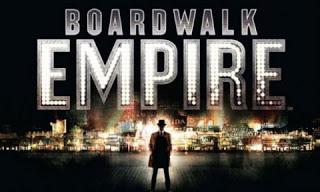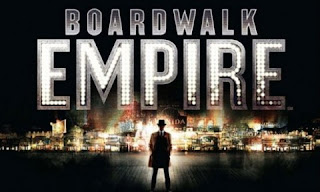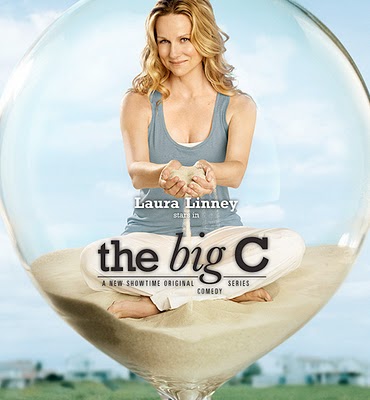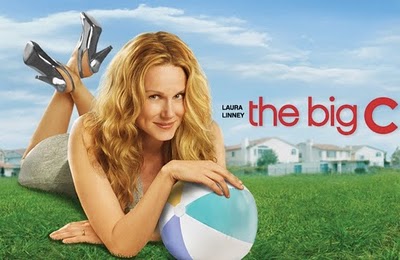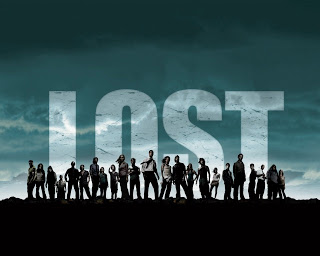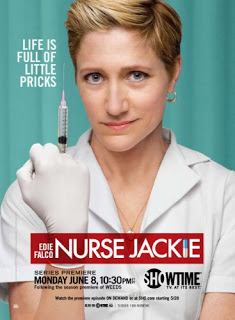Tag: TV Drama
Ripley’s Pick: The No. 1 Ladies’ Detective Agency
 |
| The No. 1 Ladies’ Detective Agency |
Guest Writer Wednesday: The Black Play Thing on The Big C
Let me say from the start that I take no issue with inter-racial relationships. I do however have a problem when Black sexuality is used as a device in the media. Much of last Monday’s episode had to do with sexuality. Cathy, played by Laura Linney, is dying of cancer and is determined to change her life before she dies. The episode begins with her standing up for herself when someone rudely steps in front her and ends with her having sex on a desk with a Black man that she barely knows. While this kind of sexual behavior is out of character from her, I am not certain that anonymous sex as liberation is a positive move for women.
Her son is 14 years old and as such he is beginning to explore his sexuality. He bumps into Andrea, who is played by Gabourey Sidibe, running laps around a track. She tells him to “stop looking at her titties.” When he denies looking at her, she tells him how great hers are and that he probably has never touched “titties” before. Of course, this leads to male bravado, which prompts her to invite him to touch her breasts. When he hesitates she grabs his hand, places it on her breast and then promptly jogs away. Considering that Gabourey’s character is nothing but filler on the show, it gives the impression that Black female bodies exist for the purposes of White male sexual experimentation. This is even further problematic when we consider the brutal history of rape and slavery that exists between White Men and Black women. You cannot divorce this narrative from a scene on television no matter how race conscious the actors themselves are. Furthermore, the language which is utilized in this scene does not inspire a full respect for Andrea’s body.
The idea that Black bodies can and should be used for sexual experimentation or as a form of rebellion is based squarely in racism. First, Cathy waxes her pubic hair and then she takes off her panties to reveal her vagina to the man she would later sleep with. Throughout the entire episode, he is not even given a name, which of course presents him as little more than a mandigo to sexually satisfy his Missy Anne. What passes between them is not sex, or even a woman finding some form of liberation — but the service of a Black buck for his mistress. Black men have time and time again functioned as a form of rebellion for White women, because our White supremacist society expects them to couple with White males. Even as White women are objectifying Black men and reducing them to roving penises, it is seen as liberation because inter-racial sex is still considered taboo by many. It is a false positive because agency should not involve the repetition of reductive constructions.
There is a difference between a loving relationship between two parties and the objectification of one group by another. Simply because White women are oppressed due to patriarchy, does not mean that they lack the ability to oppress people of colour in various instances. The very fact that their identity often becomes spoiled, once they engage in an inter-racial relationship, furthers the idea that bodies of colour exist as a form of rebellion against the sexist norm. What we learned in this episode, is that for Cathy, liberation means the freedom to break taboos and utilize the Whiteness of her body to her advantage. Considering that this program is largely White with the exception of a few appearances of Sidibe as Andrea, it seems that White woman liberation is little more than the ability to act with the same impunity as White men.
Renee Martin’s blogs include Womanist Musings, Tell It WOC Speak, and Women’s Eye on Media.
Ripley’s Rebuke: The Big C
The show centers around Cathy (Laura Linney), a middle-aged woman diagnosed with Stage IV melanoma. As of the first five episodes, only her neighbor knows that she has cancer, and she refuses to discuss the issue with her immediate family. It’s easy to identify with Cathy’s unwillingness to open up to her husband, son, and brother about her diagnosis; she’s spent most of her life mothering all of them. She wants to avoid their pity. And she wants to avoid the role reversal of going from caretaker to taken care of.
But the show goes way too far in its depiction of Cathy as a cancer-stricken woman who, instead of undergoing treatment, forgoes it in favor of “grabbing life by the balls” (the show’s actual tagline). The writers make her boringly crazy in her new zest for life: “Look, I’m pouring red wine all over my expensive couch!” … “Look, I’m shooting my son with a paintball gun on his school bus!” … “Look, I’m doing cartwheels!” … “Look, I just stole a live lobster from the restaurant tank!” Worst of all, they make her mean, not in a way that showcases her strength or even her fear, but for sheer “comedic” effect, all the while asking the audience to forgive her for lashing out—remember, she’s got cancer for god’s sake!
Check it:
In the first episode, Cathy, who apparently teaches high school (summer school in this case), fat shames Sidibe’s character, Andrea, in front of the entire class. After Andrea makes a joke about Cathy’s recent unfocused and apathetic attitude toward teaching, Cathy responds with:
You can’t be fat and mean, Andrea … If you’re gonna dish it out, you gotta be able to lick it up. Fat people are jolly for a reason. Fat repels people, but joy attracts them. Now I know everyone’s laughing at your cruel jokes, but nobody’s inviting you to the prom. So you can either be fat and jolly or a skinny bitch. It’s up to you.
Watch the Clip
What gives, Showtime? Are we supposed to laugh our asses off at Andrea’s apparently disgusting fatness? (Admittedly, it’s just hilarious every time Andrea gets caught with another bag of potato chips that Cathy’s forced to take away from her.) Or, do you just want us to feel bad for Cathy for projecting her own desire to be “healthy” onto a young highschooler who has her whole life ahead of her, earnestly telling The Fat Girl, “I just don’t want you to drop dead before you graduate … “? Read: I might have to die young, but I can make sure Andrea doesn’t!
This is all a hoot, really.
And, if I can take this further, Showtime, what are we to make of The Fat Girl’s willingness to put up with Cathy’s behavior toward her? Oh, I forgot—Fat Girls don’t feel the way “regular” people feel; they’re too busy simultaneously pounding milkshakes and scarfing Big Macs to be bothered with the nonsense of experiencing emotions. The Fat Girl’s abysmal self-esteem must not even allow her to fathom standing up for herself, right? Because all Fat Girls deep down hate themselves and sit on the couch binge-eating pizzas, gaining more and more weight, never getting invited to the prom and, therefore, never deserving authentic love (ie, not the charity-case kind) or self-respect.
Or maybe she just wants the $100 for every pound she loses. Thank god for good, old-fashioned motivation wrapped up in a little Fat Hatred, right?
Really, hilarious.
The thing is, this could’ve been an intelligent show, if it weren’t so desperately trying to avoid sentimentality and any hint of darkness. Heather Havrilesky suggests, in her review over at Salon, that perhaps the show’s creator received direction to make the whole thing a little less dark, a little less … “deathy.” She writes:
I’m going to guess that either show creator Darlene Hunt or Laura Linney or both of them were given the following note at some point: “Lighten it up!” Maybe some test audience thought the story was too gloomy, too depressing, too focused on death. “Death? Yuck!” they said. “We don’t want death! We want zany pot-dealer moms who shrug and slurp on frappuccinos! We want zany multiple-personality-disorder moms who shrug and toss back canned beer! We want zany nurse moms who shrug and pop prescription drugs and have affairs with their pharmacist buddies! But zany control-freak moms who shrug and get naked in the back yard, because they’re about to die? No thank you!”
But the strategy to “lighten up this whole Stage IV cancer thing” ultimately fails in its cliche-ridden execution.
The over the top attempt to prevent the audience from getting too bogged down in death gives us Marlene (Phyllis Somerville), Cathy’s feisty old neighbor who refuses to mow her lawn or watch her dog or interact with anyone, blah. It gives us Paul (Oliver Platt), Cathy’s husband, the witty, schlubby yet lovable man-child in constant need of mothering by his wife. It gives us Adam (Gabriel Basso), Cathy’s son, the angsty, video game playing, mother-hating teenage boy who, in one absolutely necessary scene, gets caught masturbating by his mom. It gives us Sean (John Benjamin Hickey), Cathy’s brother—my favorite, really—an eco-extremist who eats leftover food from the garbage, protests gas-guzzling SUVs with a megaphone, refuses to bathe, avoids the dentist (fuck the system, you know?), and deliberately lives as a homeless person because he’s, like, so above the establishment.
(I find Sean particularly problematic because of the unapologetic excess of white, heterosexual, male privilege, as if there aren’t people who actually don’t have the means to go to the dentist, as if millions of people aren’t actually homeless, and, by the way, who don’t also have the convenient luxury of an upper middle class sister showing up every other day with food and clothing and money. See above for previous examples of the man-child.)
Basically, the show wallows in stereotypes but doesn’t take them far enough to make much of a commentary on … anything. I want the show to say something about class issues and privilege. I want the show to say something about the health care system and how financial prosperity, or lack thereof, might impact treatment decisions. I want the show to say something about victim-blaming, about the very real challenges of a woman living with men who don’t respect her, about aging and how it feels to navigate the world in a body deemed less desirable, less able.
But this show wants to laugh at those things: “Look, I’m setting my expensive couch on fire, because I can.” … “Look! I’m paying the workers double to install my swimming pool immediately, because I can.” … “Look! I’m shaming an obese student into losing weight, because I can.” Perhaps what disappoints me most is that the show expects the audience to root for Cathy in all her reckless, carefree, unacknowledged privilege abandon, like, “Look! She’s totally grabbing life by the balls, just like the tagline said she would.”
Guest Post: Deciphering Island Patriarchy: Finding Feminism in Lost
“The Lost fathers (Benry, Widmore, Paik, Shephard the Elder) are archetypical patriarchs-rich, powerful, well-educated, well-connected, straight, and white, with the exception of Mr. Paik, who’s in the ethnic majority of his country of residence. It is within the battle among these patriarchs that everyone else is caught; it is to their whims, and their arbitrary rules and preferences, that everyone else is subjected. That’s clearly framed as Not a Good Thing, which rather suggests a feminist critique of the patriarchy.”
Guest Post: Nurse Jackie as Feminist Id?
Guest Post: Tara is Better Not United
This guest post also appears at Professor, What If… and the Ms. Magazine blog.
Alas, to my dismay, the show’s bubbly focus on a recovered Tara Gregson (Toni Collette) meant that the “alters”–alternate personalities of this 21st century Sybil–were gone, thrown out like the unwanted clothing ceremoniously dumped into a charity bin in the show opener. Instead, we have happy, functioning Tara, and an upbeat musical soundtrack trying to manipulate us to believe that, indeed, all is well in the Tara-verse.
But we soon learn that Tara as one person, no longer suffering from dissociative identity disorder, is not nearly as fun or interesting as she is as five different people. Instead, the “true Tara” now displays some of the most annoying traits of all five of her alters.
She incorporates her Alice-esque alter by donning a 50s-style apron and throwing herself into a dinner party with the neighborhood’s token gay couple. She speaks her mind Buck-style (Buck was a beer-swigging male alter) when a neighbor commits suicide, bragging “The lady with all the personalities is not the most fucked up person on the block.” After the dinner party, her T-proclivities (that was the teenaged alter) come out, and she performs a manic Bollywood number, ending with provocative thrusting in her hubby’s face. Her sister Charmaine assures her new beau that Tara has not actually “transitioned” into the other personality, indicating that perhaps it would be better if she did, while Tara’s husband Max is visibly worried that the new “sane” Tara might be more insane than before.
Given the show’s emphasis on the self as performative, and on the impossibility of performing to societal standards (especially if one is female), this suggestion that Tara’s recovery may not be a step forward is intriguing. Though the show reveals all the difficulties Tara’s disorder causes for her and her family, it also seems to be indicating that the real problem is a society that expects us to perform in very particular, stable and normative ways. These regulatory ideals are so oppressive that we either bind ourselves into limited roles (i.e., Alice-the-50s-housewife) or run the risk of being seen as “crazy”–as “normal” Tara is when she laughs too loud, makes a suicide joke or has too much fun at a dinner party.
The show’s underlying critique of such normative ideals, and the relatively freeing notion of embracing the self as performance, is evident in other characters as well. Marshall, Tara’s closeted gay son, tries hard to be serious, smart and talented, but finds that flaunting his identity by sitting at the “gay-ble”–the school lunch table where gays and their allies sit–is a welcome relief, and results in him joining a campaign at his school aimed to raise queer visibility.
Charmaine, Tara’s sister, struggles with regulatory norms in choosing between a relationship with traditional hunk Neil vs. unattractive and vertically challenged Nick, who is personality-privileged and emotionally supportive. Charmaine tried to follow normative requirements in the past by augmenting her breasts to please her then-husband, a choice that resulted in lopsided and off-center nipples. Now that she has had these “corrected,” she seems to believe she can do better than short, balding Nick.
The character of Tara’s teenaged daughter Kate has thus far been largely challenged around the regulation of her sexuality, as indicated with Tara’s concern that she was not able to “micromanage her daughter’s vagina.” Kate’s struggles with a creepy boss and an abusive boyfriend expose a society populated by males wishing for similar micro-managing power.
Max appears to be the character least affected by social norms. He doesn’t seem to care that his wife is far from typical, worrying only about her health and happiness rather than what others think. He does not condemn or regulate his son’s sexuality nor attempt to micromanage his daughter. If any character seems too good to be true, it’s him. This is perhaps why Max is a bit empty as a character: a sort of dad/husband placeholder who comes off as boring and conventional in a cast of otherwise entertaining family members.
While Robert Abele laments at L.A. Weekly that “United States of Tara plays like surface feminism with an added gloss of snark and a bewilderingly blah sentimentality,” I would counter that the snark is integral to the feminist critique the show enacts. The snark reveals that our “normal” selves are “blah,” and thus we should embrace those aspects of our identity that subvert regulatory norms lest we end up living in a world full of bores.
Diablo Cody, the show’s creator, readily admits that she asks of everything she writes, “How am I going to sneak my subversive feminist message into this?” With Tara, she sneaks in this message beautifully, conveying that societal ideals–be they a stable self, heterosexuality or conventional attractiveness–do not an exciting world (or episode) make.
Natalie Wilson, PhD is a literature and women’s studies scholar, blogger, and author. She teaches at Cal State San Marcos and specializes in the areas of gender studies, feminism, feminist theory, girl studies, militarism, body studies, boy culture and masculinity, contemporary literature, and popular culture. She is author of the blogs Professor, what if…? and Seduced by Twilight. She is a proud feminist mom of two feminist kids (one daughter, one son) and is an admitted pop-culture junkie. Her favorite food is chocolate.
What We Owe to Buffy
Ripley’s Pick: Season One of ‘True Blood’*
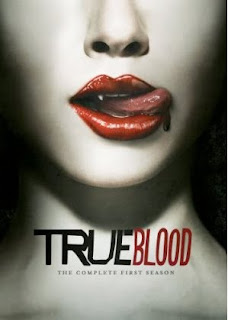 *That’s right, I said Season One. I haven’t seen a minute of Season Two, and won’t until it comes out on DVD. If Season Two contradicts everything I’ve said here, please bite your tongue–or leave your links in the comments section!
*That’s right, I said Season One. I haven’t seen a minute of Season Two, and won’t until it comes out on DVD. If Season Two contradicts everything I’ve said here, please bite your tongue–or leave your links in the comments section!
Here’s a secret: I love TV. Even more than I love movies. A television series can develop characters and story lines that are impossibly complex for a two-hour movie, and can really dig into themes and issues in ways movies can only touch upon. The high-quality television series is our generation’s answer to the 19th century serial novel–an excellent vehicle for cultural analysis and a popular genre (although most quality television is currently the domain of premium cable, which is, I admit, a problem).
A rare thing happened at work a few weeks ago: three of us (it’s a small business, and none of us has cable) started watching True Blood on DVD at the same time, allowing us to discuss a cultural object a little bit more complicated–and rewarding–than standard reality show fare.
To begin, in the words of my employer, since the show is on HBO, it’s already light years beyond anything else on TV–so even if it’s flawed, it’s hard to argue against watching (and enjoying) it.
True Blood, for the final few people unaware of the current vampire craze in the U.S., is set in small-town Louisiana a couple of years after vampires officially “came out of the coffin.” Supernatural figures and those with more mundane talents–like mind-reading and curing alcoholism & anxiety with fake exorcisms–populate Bon Temps. While the latter refers to the voodoo line True Blood refuses to cross, the former is the powerful ability of the main character, Sookie Stackhouse. (The show is based on Charlaine Harris’ series of novels about the heroine, which I haven’t read. But might.)
Rather than write a complete review of the entire first season (twelve 50-minute episodes), which I’m not sure how to do in the first place, I’ll highlight a few of the female characters and why I choose this series–despite its flaws–as a Ripley’s Pick.
Sookie Stackhouse (Anna Paquin)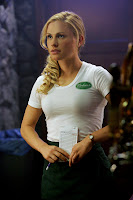 Sookie, the star of the show, is a waitress who can read minds–unless she concentrates on not listening. What draws her most to Vampire Bill is that she can’t hear his thoughts, even if she tries. Now, Sookie conforms to a lot of vampire story tropes: she is chaste (at first), in a kind of distress that warrants supernatural intervention (mostly), very pretty, and scantily clad. She is all of these things, yet she subverts so many expectations that I think the show plays with these tropes more than conforms to them. Sookie is a virgin when the show begins, but it doesn’t take long for her to run for Bill (literally) after–in a Like Water for Chocolate moment–eating a pie her grandmother made (with love). She enjoys sex, and isn’t shamed by the ‘fangbanger’ accusations hurled at her. She’s strong, independent, smart, and ultimately powerful; and even if she does wear tiny, tiny dresses, she still beheads a serial killer with a shovel.
Sookie, the star of the show, is a waitress who can read minds–unless she concentrates on not listening. What draws her most to Vampire Bill is that she can’t hear his thoughts, even if she tries. Now, Sookie conforms to a lot of vampire story tropes: she is chaste (at first), in a kind of distress that warrants supernatural intervention (mostly), very pretty, and scantily clad. She is all of these things, yet she subverts so many expectations that I think the show plays with these tropes more than conforms to them. Sookie is a virgin when the show begins, but it doesn’t take long for her to run for Bill (literally) after–in a Like Water for Chocolate moment–eating a pie her grandmother made (with love). She enjoys sex, and isn’t shamed by the ‘fangbanger’ accusations hurled at her. She’s strong, independent, smart, and ultimately powerful; and even if she does wear tiny, tiny dresses, she still beheads a serial killer with a shovel.
Tara Thornton (Rutina Wesley)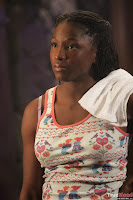 Sookie’s best friend, and my favorite character. Unlike most female characters on TV, Tara is a real woman with real problems. Aside from her shape-shifter boss/love interest, Sam, and her origins-yet-defined adolescent crush, Jason, Tara deals with isolation, loneliness, and an alcoholic Jesus-freak mother. She is independent and abrasive, and despite her best efforts, falls to the defense mechanisms of her mother (her go-to accusations of racism and sexism, drinking, demon exorcism for melancholy). She’s also wicked smart–the show opens with her reading Naomi Klein’s Shock Doctrine, and reminds us again and again that she reads for knowledge. She doesn’t always know what to do with her knowledge, however, as evidenced in her lashing out at the customer who interrupts her reading of Klein. Tara is legitimately angry, but hasn’t figured out how to direct her anger at anything but herself.
Sookie’s best friend, and my favorite character. Unlike most female characters on TV, Tara is a real woman with real problems. Aside from her shape-shifter boss/love interest, Sam, and her origins-yet-defined adolescent crush, Jason, Tara deals with isolation, loneliness, and an alcoholic Jesus-freak mother. She is independent and abrasive, and despite her best efforts, falls to the defense mechanisms of her mother (her go-to accusations of racism and sexism, drinking, demon exorcism for melancholy). She’s also wicked smart–the show opens with her reading Naomi Klein’s Shock Doctrine, and reminds us again and again that she reads for knowledge. She doesn’t always know what to do with her knowledge, however, as evidenced in her lashing out at the customer who interrupts her reading of Klein. Tara is legitimately angry, but hasn’t figured out how to direct her anger at anything but herself.
Amy Burley (Lizzy Caplan)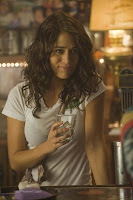 Amy Burley is a wolf in sheep’s clothing. On the surface she’s a beautiful, free-spirited wanderer who opens Jason’s eyes up to the wonders of the natural world–and vampire blood, an illegal substance with LSD qualities. While we’re charmed by her indie good looks and hippie-stuck-in-a-perpetual-summer-of-love ways, there’s something dark and evil underneath. She’s selfish and nasty, and will stop at nothing–including manipulating born-follower Jason, kidnapping, and murdering–to indulge her desire to escape into a drug-induced euphoria. Though her storyline isn’t a major one, it offers some straightforward cultural critique. Like some actual hippies in the ’60s, interested only in indulging selfish desires while Vietnam raged and the Civil Rights casualties mounted, Amy ignores reality in service of continuing her fantasy. (Those who critique the show as ultimately regressive might use her character as an example; selfish hippies are a conservative bugaboo. Or, she might just be an example of the destructive nature of human desire.)
Amy Burley is a wolf in sheep’s clothing. On the surface she’s a beautiful, free-spirited wanderer who opens Jason’s eyes up to the wonders of the natural world–and vampire blood, an illegal substance with LSD qualities. While we’re charmed by her indie good looks and hippie-stuck-in-a-perpetual-summer-of-love ways, there’s something dark and evil underneath. She’s selfish and nasty, and will stop at nothing–including manipulating born-follower Jason, kidnapping, and murdering–to indulge her desire to escape into a drug-induced euphoria. Though her storyline isn’t a major one, it offers some straightforward cultural critique. Like some actual hippies in the ’60s, interested only in indulging selfish desires while Vietnam raged and the Civil Rights casualties mounted, Amy ignores reality in service of continuing her fantasy. (Those who critique the show as ultimately regressive might use her character as an example; selfish hippies are a conservative bugaboo. Or, she might just be an example of the destructive nature of human desire.)
This barely scratches the surface of True Blood, and I do think there are some legitimate critiques of the show–despite couching many of its themes in camp. My least favorite moments in the show involve its romantic plots, which are, frankly, boring and soap opera-esque, and pale in comparison to the show’s other interests.
True Blood–like creator Alan Ball’s previous series, Six Feet Under–definitely feels like a guilty pleasure, but both shows exhibit intelligence along with entertainment. I hope Season Two, which wraps this coming Sunday night, delves further into Southern identity, sexuality, and desire–rather than losing its smarts in a storm of supernatural battles.
Documentary: When Abortion Was Illegal
In this 1992 documentary directed by Dorothy Fadiman, women (and men) tell their stories about illegal abortions, reminding us of the necessity of safe and legal access for women.
The film was nominated for an Academy Award for Best Documentary Short in 1993, and is the first in a three-part series about abortion in America.
Preview: Grey Gardens
This Saturday night (April 18), HBO premieres its new film version of the classic Grey Gardens. Starring Jessica Lange and Drew Barrymore as Big Edie Bouvier Beale and Little Edie, the film recreates scenes from the original documentary as well as providing the backstory of how these women came to find themselves in such a condition. Directed by Michael Sucsy.
Here’s the movie trailer:
Before it was a movie, of course, Grey Gardens was a fantastic documentary. Made in 1975 by David Maysles, Albert Maysles, Ellen Hovde, Muffie Meyer, and Susan Froemke, the film gives an unflinching portrait of two discarded members of the American aristocracy and their co-dependent relationship. The film is gorgeous, tragic, poetic, and haunting. One of my all-time favorites.
Here’s the original documentary trailer:
Finally, PBS’ Independent Lens made a film about the making of the documentary, and about the premiere of a Broadway show based on the lives of the women.
Here’s the PBS trailer:
‘One Woman, One Vote’: A Documentary Review
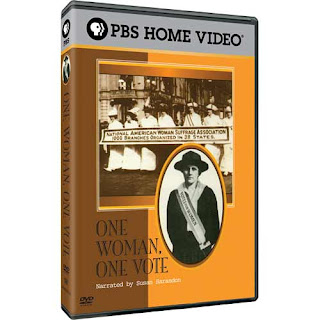 Seneca Falls. Susan B. Anthony. Elizabeth Cady Stanton. Alice Paul. Lucy Burns. Iconic American names that we recognize from our last history course, but often without knowledge of the full extent of their courage and suffering. The suffrage movement is one filled with small victories, setbacks, and defeats, and with men and women of often clashing ideas and ideologies.
Seneca Falls. Susan B. Anthony. Elizabeth Cady Stanton. Alice Paul. Lucy Burns. Iconic American names that we recognize from our last history course, but often without knowledge of the full extent of their courage and suffering. The suffrage movement is one filled with small victories, setbacks, and defeats, and with men and women of often clashing ideas and ideologies.
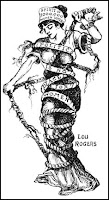 Women’s suffrage was a 72-year movement that finally attained nation-wide victory in 1920 with the ratification of the 19th constitutional amendment prohibiting sex discrimination at the polls. Up to this point, women met, organized, marched, fought amongst themselves, lobbied, and protested. They were threatened, ridiculed, attacked, beaten, tried, arrested, and placed in solitary confinement for their actions. In retaliation, they fought harder. They organized hunger strikes in prison. They surrounded the White House in protest, despite angry mobs of men who dragged them to the ground and tore not only their banners, but also clothing from their bodies.
Women’s suffrage was a 72-year movement that finally attained nation-wide victory in 1920 with the ratification of the 19th constitutional amendment prohibiting sex discrimination at the polls. Up to this point, women met, organized, marched, fought amongst themselves, lobbied, and protested. They were threatened, ridiculed, attacked, beaten, tried, arrested, and placed in solitary confinement for their actions. In retaliation, they fought harder. They organized hunger strikes in prison. They surrounded the White House in protest, despite angry mobs of men who dragged them to the ground and tore not only their banners, but also clothing from their bodies.
One of the more shocking discoveries I had from watching One Woman, One Vote was that women were not united in the cause of suffrage. There were a number of women who believed that politics were corrupt, and that women would only participate in the corruption, and sully their clean, domestic image, by voting. There was even strong disagreement amongst the suffragettes; they divided and formed separate groups on different occasions, opposing each others’ strategies and tactics for earning the vote, and finally unified when ratification of the amendment seemed inevitable. There were many diverse opinions and motivations driving the movement and its opposition, including racism, temperance, religion, and cultural norms.
 The documentary was made in 1995, but only the graphics seem dated (and, despite the fact that One Woman, One Vote is part of the PBS American Experience series, the film has no official website). Susan Sarandon narrates, and the film is full of varied voices, letters, film reels, photos, and cartoons. There are great clips of historic songs throughout, too, which are often funny, incisive, and scathing. I learned so much about a part of American and women’s history that is so often summarized into a single paragraph.
The documentary was made in 1995, but only the graphics seem dated (and, despite the fact that One Woman, One Vote is part of the PBS American Experience series, the film has no official website). Susan Sarandon narrates, and the film is full of varied voices, letters, film reels, photos, and cartoons. There are great clips of historic songs throughout, too, which are often funny, incisive, and scathing. I learned so much about a part of American and women’s history that is so often summarized into a single paragraph.
Here are a few highlights of the women who made the movement.
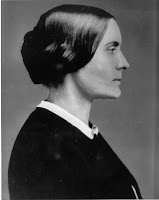 On November 5, 1872, Susan B. Anthony led a dozen women to the polls in Rochester, New York, and convinced the worker there to allow her and the others to vote—despite the fact that it was against the law. Four hours later, U.S. Marshals arrested and handcuffed Anthony. She was later convicted of a federal crime by an all-male jury–after being forbidden to testify on her own behalf (women were deemed incompetent to testify because of their sex). Before her sentencing, however, she was permitted a statement:
On November 5, 1872, Susan B. Anthony led a dozen women to the polls in Rochester, New York, and convinced the worker there to allow her and the others to vote—despite the fact that it was against the law. Four hours later, U.S. Marshals arrested and handcuffed Anthony. She was later convicted of a federal crime by an all-male jury–after being forbidden to testify on her own behalf (women were deemed incompetent to testify because of their sex). Before her sentencing, however, she was permitted a statement:
“In your ordered verdict of guilty, you have trampled underfoot every principle of our government: my natural rights, my civil rights, my political rights. I have been tried by law made by men, interpreted by men, administered by men, in favor of men, and against women. May it please, your honor, I shall never pay a dollar of your unjust penalty. Resistance to tyranny is obedience to God.”
 African American women were quite unified in their support of suffrage. However, mainstream groups were seeking the support of Southern Democrats, who strongly opposed suffrage for black women, and thus largely left black women out of their cause. Mary Church Terrell was one of the few black women invited to speak at national conventions, and there she urged white suffragists not to forget black women:
African American women were quite unified in their support of suffrage. However, mainstream groups were seeking the support of Southern Democrats, who strongly opposed suffrage for black women, and thus largely left black women out of their cause. Mary Church Terrell was one of the few black women invited to speak at national conventions, and there she urged white suffragists not to forget black women:
“Not only are colored women handicapped on account of their sex, they are everywhere mocked on account of their race. We are asking that our sisters of the dominant race do all in their power to include in their resolutions the injustices to which colored people are victims.”
Despite the efforts of Terrell and other African American leaders, they never enjoyed mainstream acceptance from the suffrage movement. Regardless, they organized and grew their supporters to half a million members, including active support from men.
 Elizabeth Cady Stanton, who first called for women’s rights at Seneca Falls (the right to vote was her most radical demand; the group met to call for property rights, divorce rights, and a woman’s right to her children), told her friend Susan B. Anthony that as she grew older, she grew more radical. Their relationship is widely considered one of the greatest relationships of the 19th century, and Stanton’s radicalism seems to be one of the few areas of disagreement–though it did not end their friendship. When Stanton was in her 70s, frustrated by women who still refused to join the suffrage movement, she denounced the church as responsible for the oppression of women.
Elizabeth Cady Stanton, who first called for women’s rights at Seneca Falls (the right to vote was her most radical demand; the group met to call for property rights, divorce rights, and a woman’s right to her children), told her friend Susan B. Anthony that as she grew older, she grew more radical. Their relationship is widely considered one of the greatest relationships of the 19th century, and Stanton’s radicalism seems to be one of the few areas of disagreement–though it did not end their friendship. When Stanton was in her 70s, frustrated by women who still refused to join the suffrage movement, she denounced the church as responsible for the oppression of women.
“The Bible teaches that woman brought sin and death into the world. I don’t believe that any man ever talked with God. The Bible was written by man, out of his love of domination.”
She rewrote every section of the Bible that degraded women, and published The Woman’s Bible, which was translated into six languages. The Woman’s Suffrage Association denounced the work, and rebuked Stanton. After her death, Stanton’s daughter, Harriet Blatch, led the movement.
 Alice Paul earned numerous academic degrees in her lifetime, and also served numerous prison sentences for acts of civil disobedience in her campaign for women’s suffrage. When she arrived in Washington in 1913, she was one of the few women in the United States who held a doctorate degree in political science. While in prison she led hunger strikes, and was tortured with forced-feedings:
Alice Paul earned numerous academic degrees in her lifetime, and also served numerous prison sentences for acts of civil disobedience in her campaign for women’s suffrage. When she arrived in Washington in 1913, she was one of the few women in the United States who held a doctorate degree in political science. While in prison she led hunger strikes, and was tortured with forced-feedings:
“Dear Mama,
The forcible feeding was terrible. They tied me to a chair because I struggled. One wardress sat astride my knees, two others held my arms and hands while two doctors forced a tube five or six feet long through my nose, like driving a stake into the ground.”
Rather than defeat her, the experience only made Paul more determined to devote her life to the suffrage movement. Among her many accomplishments were the organization of a parade that essentially upstaged the inauguration of newly-elected president Woodrow Wilson and caused a riot in the streets that brought out the U.S. Cavalry, and a “perpetual delegation” of women who picketed outside the White House, six days a week, in which women from all backgrounds stood silently with banners protesting the administration’s refusal to support a federal amendment to enfranchise women, and even outrageously mocking the president’s hypocrisy. Finally, police began to arrest the silent protesters, who were regularly being physically attacked, and charged them with obstructing traffic and imprisoned them–sometimes for months at a time.
The year was 1917. It took an additional three years for the 19th amendment to be passed and ratified by all of the states.
Remember the women who fought for women like us. We’ve only had the vote for 88 years. Exercise your right: Vote today.
Rent One Woman, One Vote from Netflix.
Purchase the DVD from PBS.
